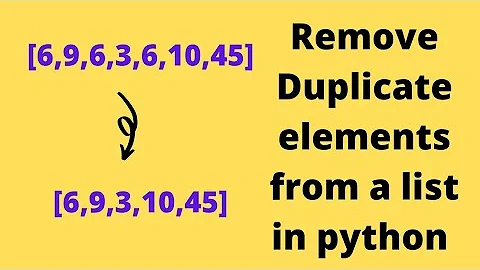How to remove duplicates from Python list and keep order?
Solution 1
A list can be sorted and deduplicated using built-in functions:
myList = sorted(set(myList))
Solution 2
If your input is already sorted, then there may be a simpler way to do it:
from operator import itemgetter
from itertools import groupby
unique_list = list(map(itemgetter(0), groupby(yourList)))
Solution 3
If you want to keep order of the original list, just use OrderedDict with None as values.
In Python2:
from collections import OrderedDict
from itertools import izip, repeat
unique_list = list(OrderedDict(izip(my_list, repeat(None))))
In Python3 it's even simpler:
from collections import OrderedDict
from itertools import repeat
unique_list = list(OrderedDict(zip(my_list, repeat(None))))
If you don't like iterators (zip and repeat) you can use a generator (works both in 2 & 3):
from collections import OrderedDict
unique_list = list(OrderedDict((element, None) for element in my_list))
Solution 4
If it's clarity you're after, rather than speed, I think this is very clear:
def sortAndUniq(input):
output = []
for x in input:
if x not in output:
output.append(x)
output.sort()
return output
It's O(n^2) though, with the repeated use of not in for each element of the input list.
Solution 5
> but I don't know how to retrieve the list members from the hash in alphabetical order.
Not really your main question, but for future reference Rod's answer using sorted can be used for traversing a dict's keys in sorted order:
for key in sorted(my_dict.keys()):
print key, my_dict[key]
...
and also because tuple's are ordered by the first member of the tuple, you can do the same with items:
for key, val in sorted(my_dict.items()):
print key, val
...
Related videos on Youtube
Comments
-
 Josh Glover over 2 years
Josh Glover over 2 yearsGiven a list of strings, I want to sort it alphabetically and remove duplicates. I know I can do this:
from sets import Set [...] myHash = Set(myList)but I don't know how to retrieve the list members from the hash in alphabetical order.
I'm not married to the hash, so any way to accomplish this will work. Also, performance is not an issue, so I'd prefer a solution that is expressed in code clearly to a fast but more opaque one.
-
 Mark Amery over 3 yearsThis question, after @ColonelPanic's edit, is kind of a mess; the question in the title and the question in the body are not the same. The title indicates that the original order, pre-duplicate-removal, should be preserved. But the body presents a scenario where this is not in fact necessary.
Mark Amery over 3 yearsThis question, after @ColonelPanic's edit, is kind of a mess; the question in the title and the question in the body are not the same. The title indicates that the original order, pre-duplicate-removal, should be preserved. But the body presents a scenario where this is not in fact necessary.
-
-
 leo7r almost 14 yearsThis can also be expressed as [e for e, _ in groupby(sortedList)]
leo7r almost 14 yearsThis can also be expressed as [e for e, _ in groupby(sortedList)] -
 J_Zar about 10 yearsThis does not work if your myList has unhashable objects.
J_Zar about 10 yearsThis does not work if your myList has unhashable objects. -
 Colonel Panic about 7 yearsThis is O(n) rather than O(n log n) right?
Colonel Panic about 7 yearsThis is O(n) rather than O(n log n) right? -
 Cristian Ciupitu almost 7 yearsFWIW something similar was added to the list of recipes from the documentation for
Cristian Ciupitu almost 7 yearsFWIW something similar was added to the list of recipes from the documentation foritertools. -
 Zuzu Corneliu almost 6 yearswouldn't set(sorted(myList)) be faster? I mean isn't it faster to first sort a list and then remove its duplicates than first removing its duplicates and only sort it afterwards?
Zuzu Corneliu almost 6 yearswouldn't set(sorted(myList)) be faster? I mean isn't it faster to first sort a list and then remove its duplicates than first removing its duplicates and only sort it afterwards? -
 Dimali over 5 years@CorneliuZuzu Removing duplicates with set() changes order, so you have to do it this way
Dimali over 5 years@CorneliuZuzu Removing duplicates with set() changes order, so you have to do it this way -
 Arthur Tacca over 4 years@CorneliuZuzu
Arthur Tacca over 4 years@CorneliuZuzusetuses a hash table rather than a tree or sorted list internally, so its speed is unaffected by whether the elements are already sorted. This also means that the items end up in hash order, which isn't the same as sorted order (as Dimali said). -
 Ken Seehart about 3 yearsDownvoted because there is a distinction between ordered and sorted. Ordered means keep the original order, e.g. f([3,1,4,1,5,9,2,6,5,3,5]) = [3,1,4,5,9,2,6]
Ken Seehart about 3 yearsDownvoted because there is a distinction between ordered and sorted. Ordered means keep the original order, e.g. f([3,1,4,1,5,9,2,6,5,3,5]) = [3,1,4,5,9,2,6] -
 Rod Daunoravicius about 3 years@user3667349 The "keep order" clause was not a part of the original question, it was added by the Colonel Panic edit in 2015.
Rod Daunoravicius about 3 years@user3667349 The "keep order" clause was not a part of the original question, it was added by the Colonel Panic edit in 2015. -
 thinkingmonster about 1 year@ZuzuCorneliu set does not maintain the order so set after sorted will again make the list unordered.
thinkingmonster about 1 year@ZuzuCorneliu set does not maintain the order so set after sorted will again make the list unordered. -
 Zuzu Corneliu about 1 yearAh yes yes, you are correct guys, it slipped my logic at the time ;)
Zuzu Corneliu about 1 yearAh yes yes, you are correct guys, it slipped my logic at the time ;)




